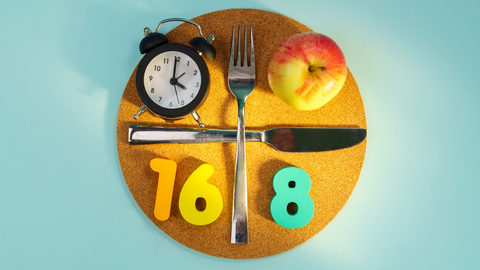Two popular weight loss methods
INTERMITENT FASTING and FREQUENT SMALL MEALS:
These approaches appear to present a paradox, as they advocate seemingly opposing methods. However, the only difference between the two lies in the frequency of meals.
Time-restricted eating more known as Intermittent fasting suggests 2-3 square meals leaving a wider gap as fasting period.
While small frequent meal points towards splitting the same amount of food into 5-6 or sometimes 7 smaller meals leaving a shorter gap as fasting period.

Fasting and Intermittent Fasting Explained
Fasting has been an ancient and commonplace practice among humans, driven by various motivations such as health, religious observances, and weight loss goals. Examples of fasting include abstaining from both food and drinks from dawn to dusk or avoiding specific foods for designated periods as part of religious rituals. Additionally, some people adopt practices like refraining from eating after 6 PM until a late breakfast the following day.
Intermittent Fasting (IF) has become an increasingly popular practice, primarily for health reasons and, more specifically, for achieving weight loss goals. It encompasses various methods, including restriction of food intake to eight hours (or fewer) per day; abstaining from food for two or more consecutive days, or adopting a pattern of eating only every other day.
Following Intermittent Fasting can be simpler if you avoid unnecessary snacks between meals and only eat when you’re hungry. One way to do this is by having an early dinner and a late breakfast, creating a longer overnight fasting period, which can be considered as practicing Intermittent Fasting.
Intermittent Fasting on Weight Loss
As popular it may be, researchers did not find the link between weight change and the practice of limiting food intake to a specific time window — often referred to as intermittent fasting.
Alternative research suggests that Intermittent Fasting might only yield a modest weight loss of 7 to 11 pounds over a ten-week period and may not be strongly linked to sustained weight loss over six years.
From a scientific standpoint, the body stores around 2,000 calories of glucose in the muscles and liver as glycogen. Furthermore, glucose can be synthesized from body fat. During fasting, the body kicks in to utilize and convert both body fat and glycogen into glucose to meet its energy demands. However, this process appears to have an insignificant impact on weight loss.
Adding to the complexity, periods of food deprivation can potentially lead to overeating or excessive consumption of carbohydrates during the eating window. Additionally, Intermittent Fasting may contribute to a slower metabolism due to the body’s adaptive response to food deprivation. This unintended consequence could result in weight gain, undermining the initial goals of the fasting approach.

Small Frequent Meal Explained
The widely employed approach of consuming ‘small, frequent meals’ finds extensive use in medical nutrition therapy, with clinical guidelines recommending an intake of six to ten meals daily. This strategy serves to alleviate bloating, address early satiety, and ensure an adequate caloric intake. Additionally, the emphasis on portion control within small meals aims to prevent overeating by offering regular, controlled amounts of food.
Moreover, the adoption of a grazing meal approach aligns with the strategy of consuming food before the stomach fully empties. This proactive approach seeks to prevent the body from defaulting to storing calories as fat—a reaction triggered when the body experiences food deprivation. Consistently consuming smaller meals contributes to the reduction of stomach size, fostering a sense of satiety even when meals are consumed in smaller quantities.
Small Frequent Meal and Weight Loss
Research has not conclusively demonstrated that consuming frequent small meals leads to increased weight loss success. However, such an eating pattern may offer other health advantages. Eating more frequently could potentially reduce feelings of hunger, which can be a factor that undermines one’s good intentions in terms of dietary choices.
In addition, small, frequent meals often tend to be in the form of convenient snacks, which contribute refined carbohydrates rather than fats and proteins to the diet. Therefore, they may add minimal nutrition to the diet for the most part. If the choice of food is unhealthy and not controlled, it can also lead to the reversal of weight loss goals. This underscores the importance of not only considering the frequency of meals but also focusing on the nutritional quality of the choices made, as this plays a crucial role in achieving and maintaining weight loss objectives.
Conclusion
While both methods yield insignificant results in weight loss, a recent study suggests that eating smaller meals more frequently may be more effective than time-restricted eating. In essence, the effectiveness of a weight loss method depends on the tastes, symptomatology, objectives, and habits of the individual. It’s important to note that altering the timing of meals alone is unlikely to prevent gradual weight gain over many years.
The most effective strategy is consistently monitoring the quality and quantity of what you eat, aligning with the long-standing and well-understood rule that reducing calorie intake contributes to weight loss. There are no shortcuts in weight loss; it always involves a combination of diet and exercise. The key is maintaining a consistent caloric intake that matches your age, lifestyle, overall health and activity level. Essentially burning what you consume.
The recommended daily calorie intake for women with a medium activity level is 2,000, while for men, it is 2,500.
Healthy Alternatives that may assist Weight Loss
Certain dietary supplements might prove beneficial in enhancing metabolism and promoting fat burning, potentially assisting in the management of weight loss. This is particularly relevant as the aging process can interfere with metabolism, making weight loss more challenging. Exploring such supplements may offer support in navigating the complexities of maintaining a healthy weight as individuals age.

Clinically proven metabolism enhancer, activates thermogenic enzymes, promoting fat burning and supporting healthy weight management.
7-Keto 50mg DHEA metabolite is 200% more effective than diet and exercise alone.

Carniblast Premium L-Carnitine
Promotes increased and sustained energy levels by transporting long-chain fatty acids to the mitochondria for beta-oxidation, to boost energy, fuel stamina, and endurance. This enhanced stamina and endurance, in turn, serve as powerful motivators to increase activity levels. As individuals engage in more rigorous physical activities, the body's demand for energy intensifies, resulting in a higher calorie burn. This synergistic effect not only supports an optimal active lifestyle but also plays a crucial role in facilitating fat loss and the efficient rebuilding of muscle mass.

Great-tasting energy vitamins that support active lifestyle. Intricately involved in cellular processes, aiding in the regeneration of red blood cells and contributing to proper energy metabolism for a healthy aging process and healthy weight.
Let us know your thoughts!


